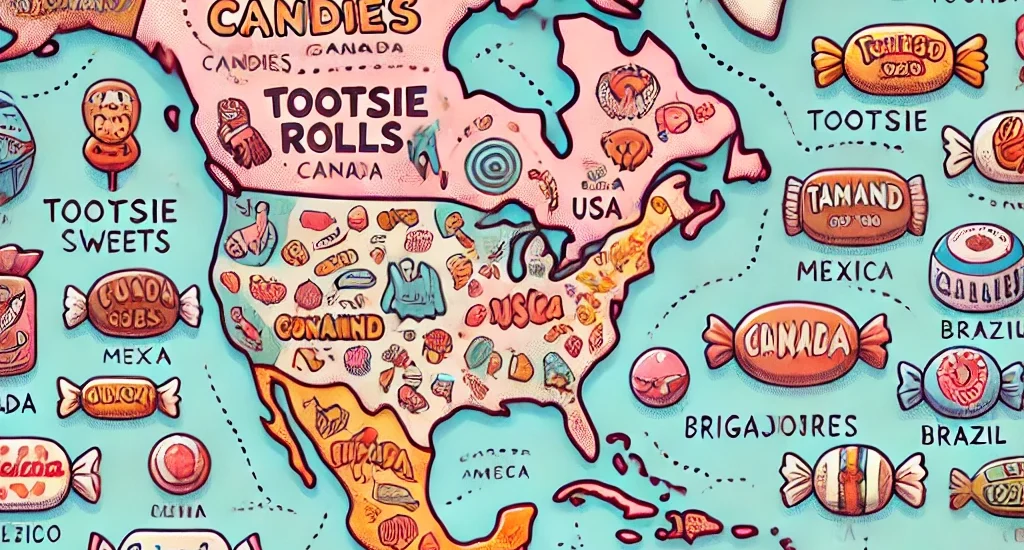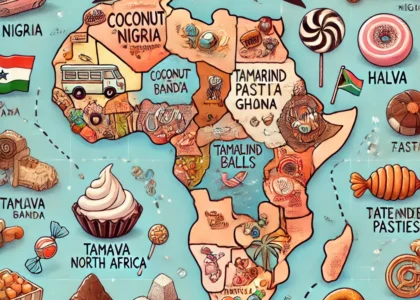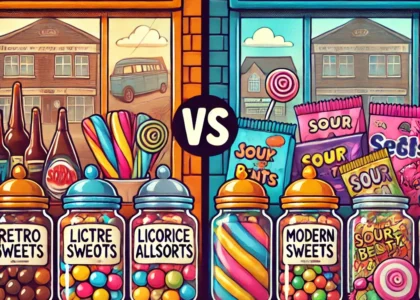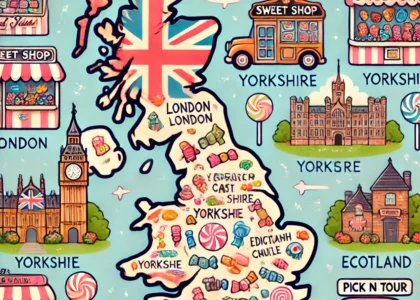Introduction: A Taste of Sweet Memories Across the Americas
From maple-flavored delights in Canada to tangy tamarind candies in Mexico, the sweets of the Americas hold a special place in the hearts of many. These nostalgic treats tell stories of after-school runs to the corner store, childhood birthday parties, and shared moments across generations. Unlike modern, polished confections, retro sweets are humble, bold, and deeply rooted in cultural identity.
In this article, we take a sugary tour across the Americas — exploring the best retro sweets from North, Central, and South America. Whether you grew up in Toronto, Lima, or Buenos Aires, there’s likely a sweet that instantly takes you back in time.
Canada: Maple Candies and Thrills Gum
Canada’s retro sweets reflect its maple heritage and British-influenced candy culture. Classics include:
- Maple Leaf Candies – hard or soft candies shaped like maple leaves, made with pure maple syrup.
- Thrills Gum – the iconic purple gum that famously “tastes like soap.”
- Mackintosh’s Toffee – rich, chewy slabs that stick to your teeth (in a good way).
- Cuban Lunch – a revival of the peanut-and-chocolate bar, nostalgic for many Prairie Canadians.
- Rockets – the Canadian version of Smarties (U.S.), a sweet-and-sour tablet.
These candies evoke memories of long winters, school lunches, and convenience store hauls.
United States: Pixy Stix and Wax Lips
The U.S. is a treasure trove of retro candies, many of which are still beloved today:
- Pixy Stix – colorful paper tubes filled with flavored sugar powder.
- Wax Lips / Fangs – novelty items kids wore and chewed at Halloween.
- Necco Wafers – chalky, pastel-colored wafers with old-timey charm.
- Charleston Chew – chocolate-coated nougat, often frozen before eating.
- Tootsie Rolls & Pops – chewy, chocolatey staples with a lollipop twist.
- Candy Cigarettes / Bubble Gum Cigars – controversial now, but ubiquitous then.
These sweets are icons of American pop culture, often sold in retro candy stores and themed diners.
Mexico: Tamarind and Chili Delights
Mexican retro sweets are bold, spicy, and tangy — not for the faint-hearted. Popular classics include:
- Pulparindo – tamarind paste bars dusted with chili and sugar.
- Pelon Pelo Rico – tamarind goo squeezed through a tube to mimic “hair.”
- Duvalín – creamy, Nutella-like dessert in tiny plastic pots with a spoon.
- Mazapán de la Rosa – peanut marzipan wrapped in delicate paper.
- Vero Mango / Vero Elote – lollipops coated in chili powder with fruity centers.
Many of these remain staples at corner tiendas and are deeply tied to Mexican childhood memories.
Brazil: Paçoca and Maria-Mole
Brazilian sweets are rich, nutty, and sometimes tropical. Retro favorites include:
- Paçoca – crumbly, sweet peanut candy, similar to powdery fudge.
- Maria-Mole – coconut-flavored marshmallow dusted in sugar.
- Bala de Coco – chewy coconut toffees given out at parties.
- Dadinho – “little dice” peanut confections in colorful wrappers.
- Bala 7 Belo – pink, fruity hard candies known for their perfume-like flavor.
These are often found at school fêtes (festas juninas), street vendors, and in the homes of every Brazilian grandmother.
Argentina: Mantecol and Sugus
Argentina’s retro sweets combine European influence with homegrown creativity:
- Mantecol – a halva-like peanut-based bar with a soft, crumbly texture.
- Sugus – chewy fruit candies originally imported from Switzerland, now part of local culture.
- Bon o Bon – round candy with a crispy peanut filling covered in chocolate.
- Tita & Rhodesia – classic biscuit bars, one covered in chocolate, the other lemon-flavored.
- Yapa – bubble gum with hidden sticker surprises.
These are sold in kioscos (kiosks) and are synonymous with 80s–90s Argentine school life.
Colombia: Bocadillo and Bon Bon Bum
Colombia’s sweets are often made from local fruits and cane sugar. Retro picks include:
- Bocadillo – guava paste wrapped in plantain leaf, often paired with cheese.
- Bon Bon Bum – bubble gum lollipops with flavors like cherry and watermelon.
- Manimoto – peanuts coated in a crunchy glaze.
- Arequipe Wafers – sandwich cookies filled with creamy dulce de leche.
- Supercoco – hard coconut candy with bold flavor.
These sweets are a cultural staple, blending tropical ingredients with playful packaging.
Peru: Doña Pepa and Sublime
Peru’s old-school sweets reflect a deep love for rich, chocolatey, and anise-based flavors:
- Chocolate Sublime – milk chocolate with peanut pieces.
- Doña Pepa Cookies – anise cookies coated in sprinkles and chocolate, traditionally eaten during religious festivals.
- Chocotejas – chocolate-covered fruit and nut candies from Ica.
- Canchita Dulce – sweet popcorn with a candy shell.
- Caramelos de Menta – simple mint candies that evoke school days.
Street vendors still sell many of these near parks and schools.
Chile: Fruna and Super 8
Chile’s retro sweets combine chewiness and crunch in just the right way:
- Fruna – soft, fruity taffy in colorful wrappers.
- Super 8 – chocolate wafer bars, a childhood lunchbox staple.
- Calugas de Leche – soft milk caramels, homemade or wrapped in wax paper.
- Alfajores – while often associated with Argentina, Chile has its own beloved versions filled with dulce de leche.
Supermarkets and street stands carry these sweets even today.
Venezuela: Toronto and Pirulín
Despite economic hardship, Venezuela has produced iconic retro candies that generations still adore:
- Toronto – round chocolate balls with a hazelnut center.
- Pirulín – wafer tubes filled with hazelnut cream.
- Susy – chocolate-covered wafer with a cult following.
- Chupi Chup – Venezuela’s version of the lollipop, made in local factories.
- Caramelos de Café – old-school coffee candies found in grandparents’ homes.
These treats have become symbols of national identity, both in Venezuela and among the diaspora.
Central America Highlights (El Salvador, Guatemala, Honduras, Nicaragua, Costa Rica, Panama)
Many Central American countries share a love for coconut, tamarind, and homemade sweets:
- Cocadas (widely across the region) – coconut candies baked or boiled with sugar.
- Tamarindo Balls – spicy-sweet tamarind pulp rolled with chili and sugar.
- Melcochas – traditional handmade toffee or caramel ropes.
- Chicles Motita (Guatemala) – small, colorful gums from the 80s/90s.
- Alfeñiques – molded sugar figurines used in celebrations (especially in Guatemala).
These sweets are often handcrafted and deeply regional — more often made at home or in local markets than factories.
Caribbean Islands: Sugar Cakes and Guava Sweets
Caribbean sweets are full of tropical fruits, spices, and cane sugar:
- Sugar Cakes (Barbados, Trinidad) – shredded coconut and sugar, dyed in bright pinks and whites.
- Guava Cheese (Bocados de Guayaba) – firm guava paste, sliced and eaten with cheese or alone.
- Tamarind Balls – spicy-sweet tamarind rolled in sugar, popular in Jamaica and Trinidad.
- Coconut Drops / Gizzada (Jamaica) – chewy coconut treats.
- Busta Candy – hard caramel sweets, sometimes with ginger.
Often sold at roadside stands, these candies are as much part of the island culture as music and dance.
Conclusion: From Maple to Tamarind — A Sweet Mosaic of Cultures
Retro sweets in the Americas aren’t just sugar and flavor — they’re tokens of identity, memory, and pride. From Canada’s quirky soap-tasting gum to Colombia’s tropical Bon Bon Bum, every country has a few humble candies that define entire generations. Many are still in circulation, others now nostalgic collectibles — but all remain etched in cultural memory.
Whether you grew up chewing Paçoca in Brazil or trading Pixy Stix in an American lunchroom, the simple joy of retro sweets continues to connect people across the continent, one sugary bite at a time.





